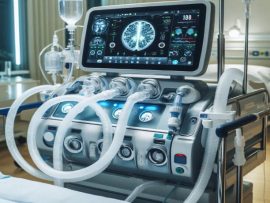Abstract Postoperative organ dysfunction remains a major challenge in adult cardiac surgery with cardiopulmonary bypass (CPB), frequently involving the kidneys, heart, and lungs. These complications are primarily driven by hemolysis,..
Read MoreAbstract Solutions to reduce the need for systemic anticoagulation during extracorporeal life support would improve safety and utility. The study objective was to evaluate the safety and efficacy of a..
Read MoreAbstract Background: Inhalational anesthetic agents are a major source of potent greenhouse gases in the medical sector, and reducing their emissions is a readily addressable goal. Nitrous oxide (N2O) has..
Read MoreAbstract Background: Postoperative Acute kidney injury (AKI) is a significant concern for cardiac surgery patients with chronic kidney disease (CKD). Effective pharmacological interventions to mitigate these risks are urgently needed...
Read MoreAbstract Objective This study aimed to assess the safety and potential efficacy of high-dose inhaled nitric oxide therapy for the prevention of postoperative pneumonia in cardiac surgery patients Methods A..
Read MoreAbstract Importance Children with congenital heart defects who undergo cardiopulmonary bypass (CPB) surgery are at risk for delayed or impaired neurodevelopmental outcomes. Nitric oxide (NO) added to the CPB oxygenator may..
Read MoreAbstract This study presents the utilization of a novel, highly lipophilic nitric oxide (NO) donor molecule, S-nitroso-1-adamantanethiol (SNAT), for developing an NO-emitting polymer surface aimed at preventing thrombus formation and bacterial..
Read MoreAbstract Nitric oxide (NO) was proclaimed the 1992 “molecule of the year” by Culotta in Science magazine because of its importance in neuroscience, physiology and immunology. Inhaled NO has been..
Read MoreAbstract The effect of nitric oxide (NO) supplied to the sweep gas of the oxygenator on the formation of gaseous microemboli during cardiopulmonary bypass has been studied in animal experiments..
Read MoreAbstract Nitric oxide (NO), a selective pulmonary vasodilator, can be delivered via conventional ICU and anesthesia machine ventilators. Anesthesia machines are designed for rebreathing of circulating gases, reducing volatile anesthetic..
Read MoreAbstract BACKGROUND Cardiac surgery involving cardiopulmonary bypass induces a significant systemic inflammatory response, contributing to various postoperative complications, including pulmonary dysfunction, myocardial and kidney injuries. OBJECTIVE To investigate the effect..
Read MoreAbstract Objective The impact of nitric oxide (NO) administered via cardiopulmonary bypass (CPB) on pediatric heart surgery remains controversial. The objective of this study is to conduct a comprehensive systematic..
Read MoreThe Nephroprotective Effect of Nitric Oxide during Extracorporeal Circulation: An Experimental Study
Abstract This study aims to determine the effectiveness of administering 80 ppm nitric oxide in reducing kidney injury, mitochondrial dysfunction and regulated cell death in kidneys during experimental perfusion. Twenty-four..
Read MoreAbstract Cardiac surgeries under cardiopulmonary bypass (CPB) are complex procedures with high incidence of complications, morbidity and mortality. The inhaled nitric oxide (iNO) has been frequently used as an important..
Read MoreAbstract Background: Nitric Oxide (NO) is a naturally occurring modulator of inflammation found in the human body. Several studies in the pediatric cardiothoracic surgery literature have demonstrated some beneficial clinical effects..
Read MoreAbstract Nitric oxide (NO) can be safely delivered through the sweep gas to the oxygenator of an extracorporeal membrane oxygenation (ECMO) circuit. It has theoretical benefits such as preventing platelet..
Read MoreAbstract Background: The during (CPB) to improve Recovery in Infants with (NITRIC) trial, a 1320-patient, multicentre, , is aiming to improve survival free of ventilation after CPB by using nitric oxide delivered into the of the..
Read MoreAbstract Background Nitric oxide (NO) is a gas naturally produced by the human body that plays an important physiological role. Specifically, it binds guanylyl cyclase to induce smooth muscle relaxation...
Read MoreAbstract Introduction The objective of this study was to investigate the potential synergistic utility of a combination of gaseous nitric oxide (gNO)-intravenous Cangrelor as an effective pharmacological option for the..
Read MoreAbstract Objective. To evaluate the effect of NO added to the sweep gas of the oxygenator during cardiopulmonary bypass (CPB) on the liver and kidneys in pigs. Methods. An experiment..
Read MoreAbstract Background Children with end-stage lung disease are commonly managed with extracorporeal life support (ECLS) as a bridge to lung transplantation. A pumpless artificial lung (MLung) is a portable alternative..
Read MoreAbstract Purpose Investigate inhaled nitric oxide’s influence on mortality rates, mechanical ventilation and cardiopulmonary bypass duration, and length of stay in the intensive care unit and hospital when administered during..
Read MoreAbstract Background and aims: Cardiopulmonary bypass (CPB) utilized for cardiac surgeries has been associated with significant mortality and adverse outcomes. The benefits of incorporating nitric oxide (NO) into the CPB..
Read MoreAbstract Background Extracorporeal life support (ECLS) has extensive applications in managing patients with acute cardiac and pulmonary failure. Two primary modalities of ECLS, cardiopulmonary bypass (CPB) and extracorporeal membrane oxygenation..
Read MoreAbstract BACKGROUND: Right ventricular failure (RVF) is a leading driver of morbidity and mortality after major cardiac surgery for advanced heart failure, including orthotopic heart transplantation and left ventricular assist..
Read MoreAbstract Objective Several human studies have associated nitric oxide administration via the cardiopulmonary bypass circuit with decreased incidence of cardiopulmonary bypass–associated acute kidney injury, but histopathologic and serologic evidence of..
Read MoreAbstract Nitric oxide (NO) incorporation into the sweep gas of the extracorporeal life support (ECLS) circuit has been proposed as a strategy to ameliorate the insults caused by the systemic..
Read MoreAbstract Importance In children undergoing heart surgery, nitric oxide administered into the gas flow of the cardiopulmonary bypass oxygenator may reduce postoperative low cardiac output syndrome, leading to improved recovery and..
Read MoreSummary Current knowledge regarding mechanisms underlying cardiovascular complications in patients with COVID-19 is limited and urgently needed. We shed light on a previously unrecognized mechanism and unravel a key role..
Read MoreAbstract Background: Clot formation on foreign surfaces of extracorporeal membrane oxygenation systems is a frequent event. Herein, we show an approach that mimics the enzymatic process of endogenous nitric oxide..
Read More










